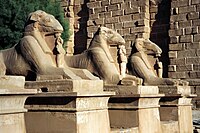Egyptian sphinx
Sphinx (from the Greek Σφίγξ) is the Hellenized name of a fabulous being that is usually represented as a reclining lion with a human head. Sphinxes were devised by the ancient Egyptians and are part of their complex mythology. Some sphinx sculptures were built in front of a temple (avenue of the sphinxes) based on the belief that they came to life and protected the temple at night.
Etymology
The ancient Egyptians called it Sheps-anj, which means "living image" or "living statue"; later it derived to sephanxes (sephankhes) and later to sphinx. Herodotus called Androesphinx to the Egyptian, who had a male face unlike the Greek, with a feminine and winged appearance. There were also those with the head of a ram, called cryosphinges, or falcons, called hieracosphinges.
History
The sphinxes were a symbol of royalty, as they represented the strength and power of the lion, and life after death, which is why they appear in relief in many tombs. During the New Kingdom, some gods, such as Amun, were represented as sphinxes.
The largest and one of the oldest sculptural representations is the Great Sphinx found in Giza. In the last periods it was customary to place sphinxes on both sides of the avenues that led to the temples. Between the enclosure of the temple of Amun in Karnak and that of Amun in Luxor, there is a processional avenue (dromos) of several kilometers flanked by hundreds of sphinxes with rams or human heads.
The Egyptian sphinx has varied throughout history, changing its appearance according to current cultural trends. Some with a female appearance are known: the sphinx of Hetepheres II is the oldest known. The one in the Barracco Museum in Rome, made of black granite and attributed to Hatshepsut, and another preserved in the Cairo Museum of the same queen, would be the image of the first queen-pharaoh to be represented in this way. Other queens whose face can be seen on sphinxes were Mutnedyemet and Nefertiti.
Contenido relacionado
Aeschylus
Alexander I (pope)
Persecution of Christians



